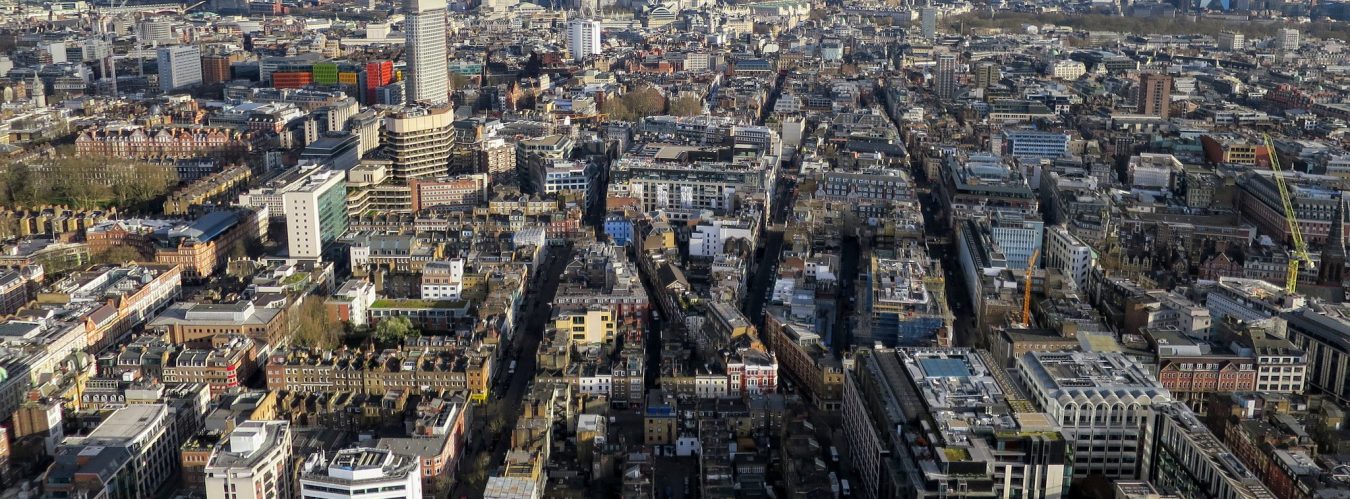Centre Point Tower, Centre Point House, Link Bridge and Surrounds.
Comments from: Bloomsbury Association, CGCA, Seven Dials Trust & the Soho Society.
THE APPLICATION
Change of use of Centre Point Tower from office (Class B1) and restaurant/bar (Sui Generis) to residential (Class C3) to provide 82 self contained flats (16 x one bedroom, 37 x two bedroom, 26 x three bedroom, 2 x 4 bedroom and 1 x 4 bedroom duplex) and ancillary residential floorspace (spa, gym, pool and club); change of use of Centre Point Link from office (Class B1) and bar (Class A4) to a flexible retail/restaurant/bar use (Class A1/A3/A4) and the erection of a ground floor extension partially infilling under the bridge link; change of use of Centre Point House at first and second floor levels from office (Class B1) to flexible retail/restaurant/bar use (Class A1, A3, A4); alterations and extensions to the existing building at ground floor level to provide flexible retail/restaurant/bar use (Class A1, A3, A4). Alterations to the external elevations of Centre Point Tower, Centre Point Link and Centre Point House including the relocation internally of the existing external ground and mezzanine eastern and western staircases, replacement and refurbishment of the facades, fenestrations and shopfronts, new pedestrian link through Centre Point House and associated basement car parking, terraces, landscaping, public realm, highway works (including the closure of the northern part of St Giles High Street and the relocation of bus stands to Earnshaw Street), servicing and access arrangements and extract ducts.
A.
The groups responding jointly are in general support of this application but wish to have the following comments relayed to the DCSC:
A. HOUSING
We welcome the change of use of the Centre Point Tower to housing; however this requires substantial affordable housing input.
- On the basis of 24,000s sqM (the size of the Tower) onsite affordable would be 12,000 sqM;
- Offsite would be 24,000 sqM (provided by the developers. If the above are considered unfeasible then the financial contribution would be c. £35m (housing to be provided by Camden);
- All of the above would need to be within either the CG & Holborn ward or the Bloomsbury ward.
The applicant has proposed 13 units totalling 1,900 sqM, on-site, and a viability study supporting same.
B. OTHER PROPOSED USES
- We would encourage the applicant to encourage uses that will act as a catalyst to uplift this rather run-down area;
- Reassurance that the mix of uses will discourage the spread of night-time bars out of Soho and Covent Garden, and in particular no nightclubs and limited A4 use;
- A condition in leases or via a S.106 Agreement that any alcohol licence must cease at 12 midnight (i.e. Camden Framework Hours) as the site falls within the extended Seven Dials Special Policy Area. Clearly the applicant would be at liberty to request revising the foregoing if uses demonstrated they met the objectives of the 2003 Licensing Act.
C. PUBLIC REALM ISSUES
The public realm proposals join those proposed by Consolidated for their adjacent site. It appears this might mean buses continued to operate through Denmark Street (see under ‘Site Management’ below).
- The public realm proposals should be integrated with those proposed by Consolidated with a time-table for implementation given Crossrail works and once this is done be available for further public comment and be exhibited. This should include a coordinated and consistent landscape, lighting and signage strategy for all the land in various ownerships. We would like to be consulted on the detail of the proposed public realm materials, for example the use of multi-coloured dressed setts as in Monmouth Street as part of the Seven Dials Renaissance Partnership, followed in Long Acre and Mercer South (WCC CG Area 3);
- As the overall land is part public and part private, a management strategy encompassing the whole area involving Almacantar, Consolidated and Camden and possibly secured via a S.106 Agreement for both this application and the adjacent one by Consolidated;
- Evidence that wind, sun and shading studies were carried out to inform proposals for the public space. This is critical in the case of tall buildings, particularly in an urban environment. The same applies to acoustics, particularly traffic generated noise;
- A possible centrally located piece of public art as long as the cost of same does not detract from the quality of public realm materials. A specially commissioned major sculpture. e.g. as Calder in NYC, Caro, Kapoor, Heatherwick… etc. Something that gets a nickname and is a future meeting point. It could be really big, almost too big for the space! It needs to be iconic, something like Eros, or the Seven Dials Sun Dial Pillar. The column in Paternoster Square is an exemplar and would benefit both developers as an iconic meeting point;
- A time-table for the proposed public realm works (for both this and the Consolidated scheme). Will these works have to await completion of either or both schemes? How do they relate to the Crossrail timetable etc?
D. PEDESTRIAN MOVEMENT TO ADJACENT AREAS
Unfortunately the development of Centrepoint removed the most direct route from the TCR area down to Covent Garden through Seven Dials (see Farrell TCR Study).
- A more thorough understanding of context, of the opportunities for connection to the immediate hinterland through exploiting pedestrian movement patterns. In particular, a better link to Neal Street, and Earlham Street and thus through to Covent Garden via Seven Dials with a pedestrian link across Earnshaw Street and through St Giles Court;
- Possible use of the same template as Seven Dials and CG Area 3 for footways and carriageways so as to assist in identifying pedestrian routes;
- Key to the design of the public realm is pedestrian movement. The importance of St Giles Circus could be compared to that of Trafalgar Square and Oxford Circus. Key to TS and Oxford Circus were on-site pedestrian movement surveys followed by computer simulation by Space Syntax, then Intelligent Space. These were interactive so you could test different routes and establish real desire lines. We think this process would give a real structure to the very bland and static looking public realm as shown. It needs a proper sun path study particularly because parts of the public areas are heavily shadowed by the buildings, old and recent and better consideration of possible materials as above;
E. THE BUILDING
- The Listing states: ‘Above the top storey is an open viewing gallery with the words ‘CENTRE POINT’ in neon-lit capital letters running along either side; these are a later addition.’ We feel this should be brought back into use or similar created and as there are 6 lifts this should be feasible (for pre-booked groups for security reasons). We assume this was included in the listing description as part of the ‘social character’ of the building.
- New double glazing that retains the same colour and reflective qualities of the existing glass.
- Clean stonework;
- Central provision of heating/cooling and hot water to each unit through renewable energy solutions. We understand that all plant will be in the basement. Is this correct?
- What future use is proposed for the basement? Is it all Plant?
- Is car parking really necessary in an area of high public transport accessibility and can the ramp on Earnshaw Street be removed?
- What makes Centre Point so interesting for its aficionados? It could be said that the attractive brashness of the building is what makes it so interesting and contributed to its listing – does the re-cladding of the tower facades (infill) lack the attractive brashness of the original?

